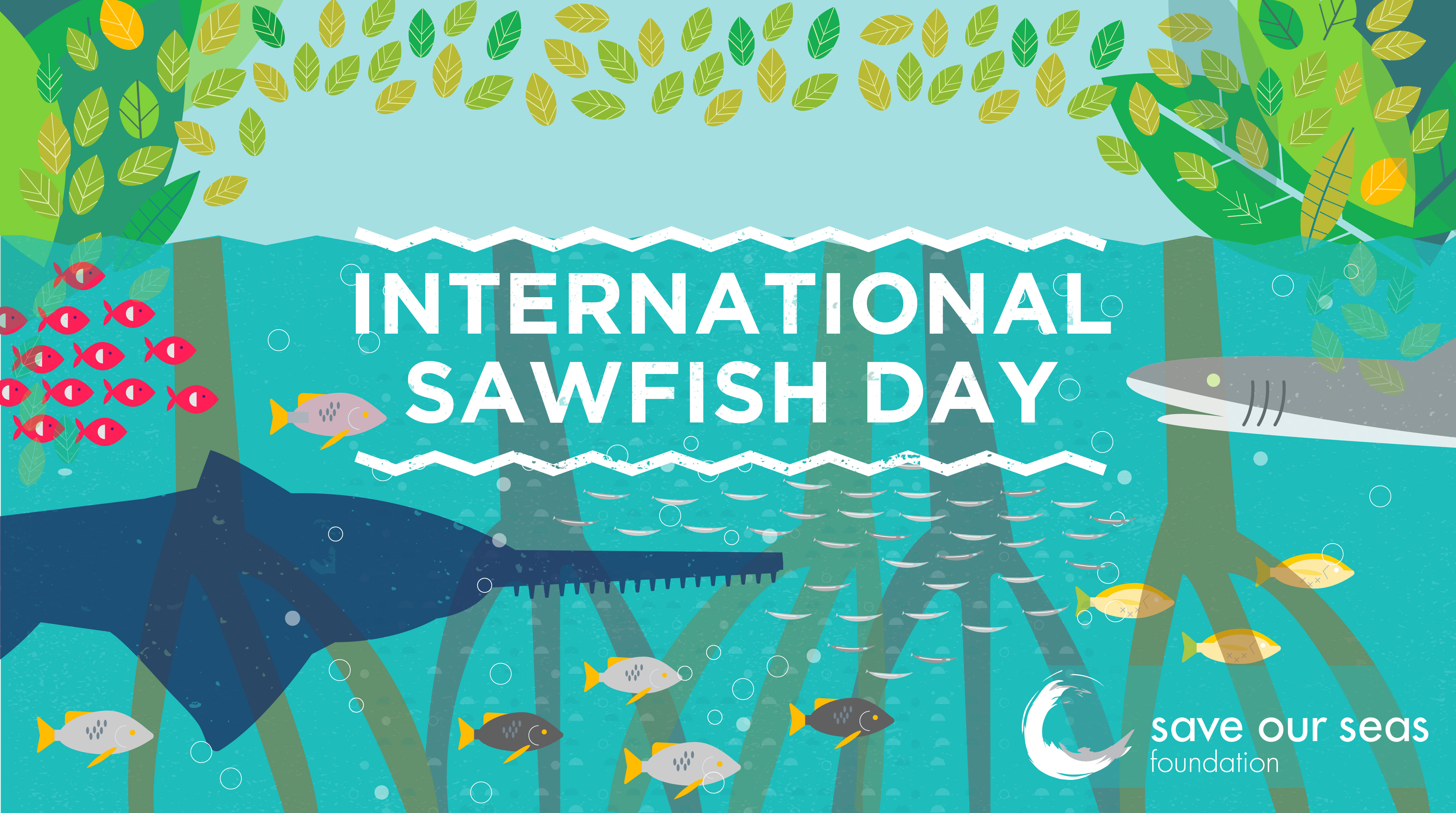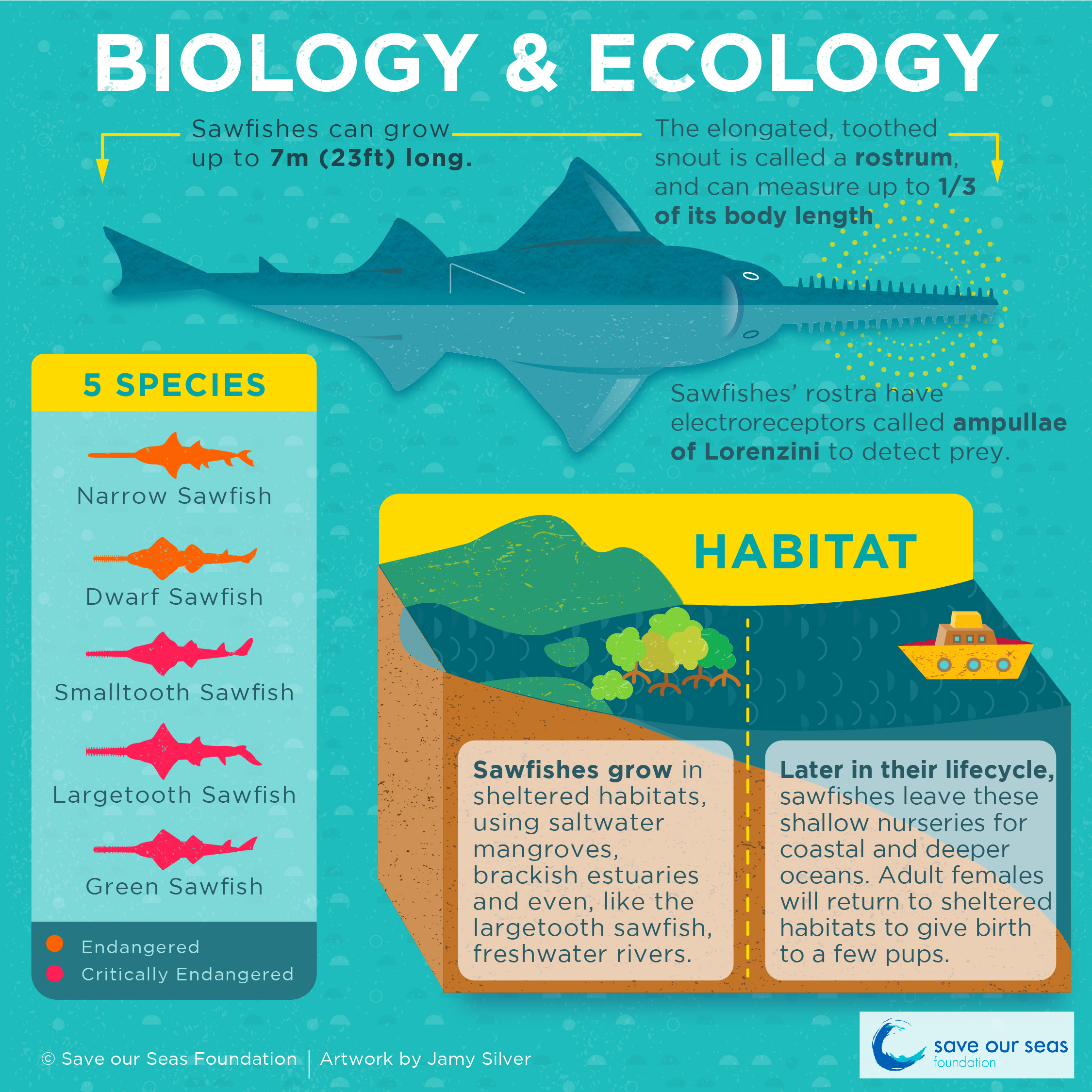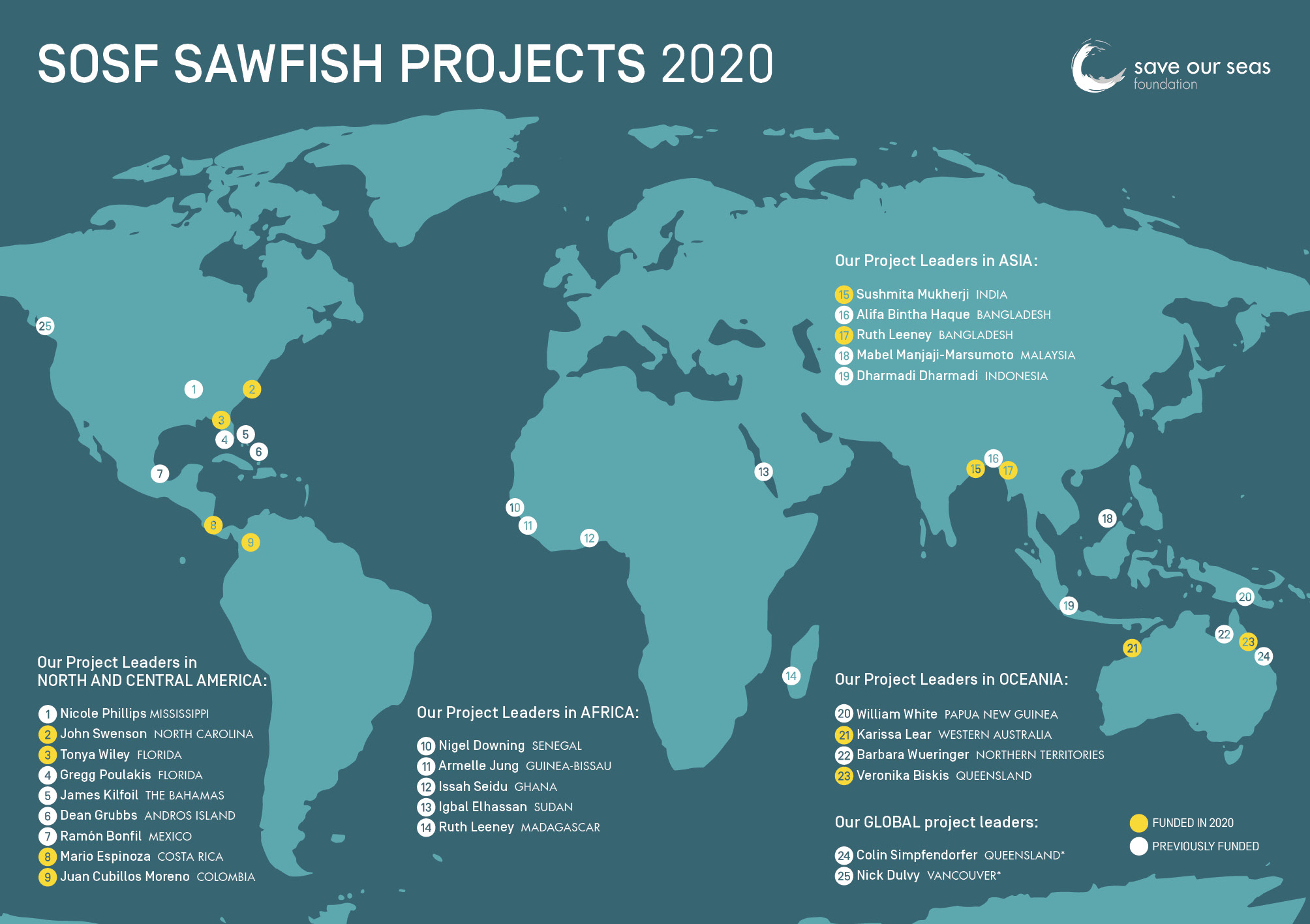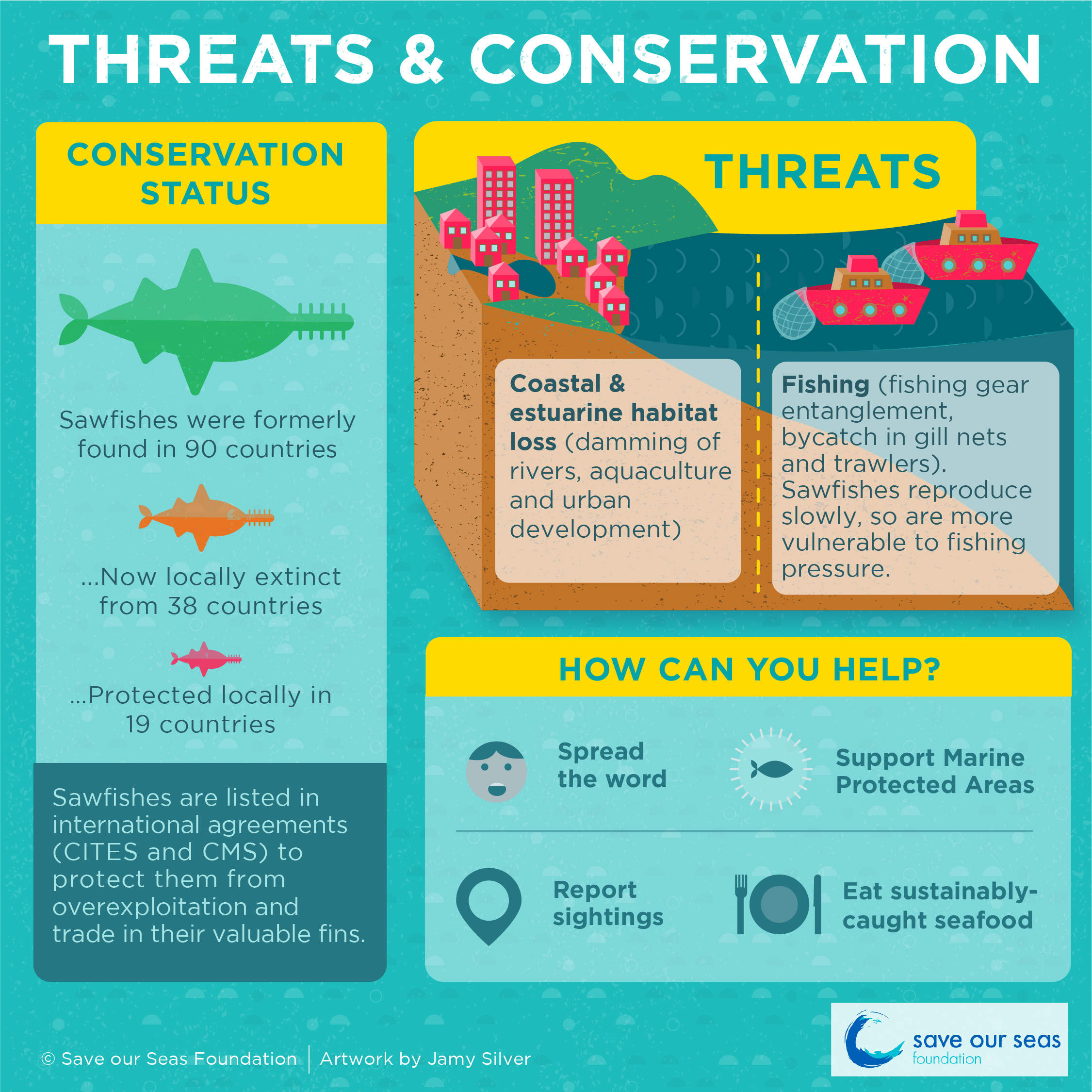Celebrating International Sawfish Day
October 17th marks an important day on our calendars where we highlight one of our oceans most marvellous creatures – International Sawfish Day. First launched in 2016, this day is dedicated to increasing knowledge and awareness of one of the most endangered groups of elasmobranchs.
As long-time supporters of sawfish research and conservation efforts, we’re joining the celebration to highlight their wonder, their role in keeping our ecosystems healthy and balanced, and the threats they face. This International Sawfish Day, we’ll be sharing interesting resources and fun facts about these saw-snouted fishes on social media throughout the day.

Artwork by Jamy Silver | © Save Our Seas Foundation
Sawfishes are some of the oceans’ most intriguing creatures, growing up to 7 m in length with a saw-like snout, known as the rostrum. Their prehistoric and other-worldly form may have you thinking they belong in the deepest parts of the ocean, however, this shark-like ray species prefer warm coastal waters and is often found in murky rivers. Due to their decimated populations and preference for turbid river waters, sawfishes have kept the scientific research community on their toes for years, as they can be extremely difficult to find and collect data on. These slow-breeding, long-lived creatures are heavily overfished for their meat and fins, and their rostra (the saw) often get them tangled in fishing gear. Furthermore, their habitats continue to disappear as coastal areas become increasingly developed.

Artwork by Jamy Silver | © Save Our Seas Foundation
Our Project Leaders and their work:
Over the last 17 years, SOSF has funded over 25 projects dedicated to sawfish around the world. We aim to highlight their threats and to work with communities to make sure we don’t lose sawfish entirely.
SOSF is proud to be a part of the solution with seven project leaders out in the field this year, trying to crack the code on sawfishes mysterious lives.

Artwork by Nicola Poulos | © Save Our Seas Foundation
Our project leaders in North and Central America:
Dean Grubbs
All about sawfishes in the Bahamas: tracking movement, breeding and nurseries – Dean’s research is focused on the biology and ecology of the smalltooth sawfish, and he concentrates his efforts around the island of Andros in the Bahamas.
Tonya Wiley
The Sawfish Sleuth – Tonya is searching for clues as to how and where smalltooth sawfish populations might begin to recover in the Tampa Bay Area should they have some protective measures in place.
Mario Espinoza
Tracing sawfishes in the last habitats of Costa Rica – Mario is using traditional fishing techniques in combination with eDNA (traces of sawfish DNA left behind in the environment) sampling to document where the last habitats for sawfishes can be found in Costa Rica.
Juan Cubillos Moreno
Searching for ‘El Guacapa’ with eDNA – Juan is collecting eDNA samples from the estuaries and mangroves of Colombia’s Chocó region with the aim of learning more about where exactly the critically endangered largetooth sawfish occurs. Known locally as ‘El Guacapa’, they are typically found in estuaries and thought to be resident in some of Central and South America’s freshwater systems. Knowing exactly where this sawfish occurs is critical to its conservation.
Jeff Whitty
Providing saefish education for global conservation action – Jeff is on a mission to create high-quality and accurate educational materials in at least six languages that will create awareness around all five species of sawfish.
Fabio Cuelio Mercado
Managing mangroves and MPAs for Colombia’s largetooth sawfish – Fabio is working for mangroves and towards an MPA by restoring native species, collecting plastic waste and demarcating important coastal areas. All this, in a bid to bring to life a comprehensive strategy to save largetooth sawfish off the coast of Colombia.
Our Project Leaders in Africa:
Issah Seidu
Filing in the gaps for Ghana’s shark fisheries – By trawling the fish markets and landing sites of Ghana’s coastline, Issah is surveying the patterns in catch composition over time for sharks and rays in artisanal fisheries. In doing so, he is also raising awareness about the best fishing practices that safeguard sharks and rays and garnering fishers’ support for sharks and the conservation of ocean ecosystems in Ghana.
Our Project Leaders in Asia:
Alifa Binta Haque
Honing in on habitats – Annual encounters with the four sawfish species found in Bangladesh are reported to have been declining drastically over the past five years. Alifa is training local fishers to help map where these Critically Endangered species were found and what habitat is essential for their survival today.
Ruth Leeney
Bridging the gap – From research to conservation for sawfishes in Bangladesh – Ruth is aiming to develop educational and awareness-raising tools to reach fishing communities in Bangladesh, and highlight that they can become stewards of one of the last remaining populations of largetooth sawfish in the world.
Michael Grant
Re-writing the sawfish story: inspiring community-driven conservation of sawfish in Papua New Guinea – Michael is dedicated to the conservation of Papua New Guinea’s sawfishes, and in providing materials for children so that they understand their incredible natural inheritance. His fieldwork entails observing fishing activity at each fishing village as the team travels through remote Papua New Guinea.
Our Project Leaders in Australia:
Veronika Biskis
A new use for old things: saving sawfishes with repurposed rostra – Veronika is giving old sawfish trophies a new lease on life by constructing 25 educational cases that will be displayed across Far North Queensland. In doing so, she is hoping to transform these rostra into a symbol of hope and caution that connects communities to the conservation of sawfishes.

Artwork by Jamy Silver | © Save Our Seas Foundation
What can you do?
By reading this post, you’re already on your way to making a difference. Now, you can share your love for these incredible animals, following our social media pages and the hashtag #IntlSawfishDay2020. Learn more from other organisations doing their best to help sawfishes and share everything you learn with family and friends, at school and at work. Use your voice to lobby for the enforcement of protection measures.
SOSF keystone project leader and top international sawfish researcher Ruth Leeney advises that we should support organisations at home as well as those that are working in low-income countries through donations. By helping them to continue their focused and informed work on the ground to address local issues you can make a real difference for the animals and the people who share their habitat.

Small-tooth Sawfish. Photo © Tonya Wiley
